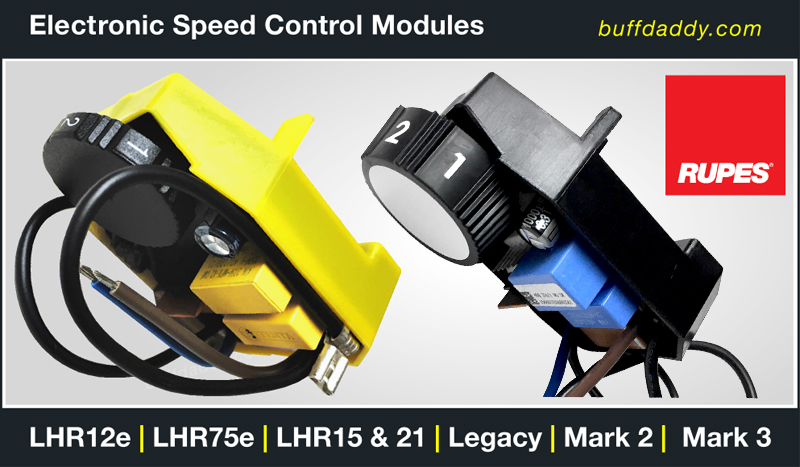
Rupes ECM Electronic Speed Control Module
 |
            |
| Click to enlarge image(s) |

Factory Replacement Electronic Speed Control Modules.
As electricity flows into a BigFoot Polisher, it immediately passes through the Electronic Speed Control Module (also referred to as an ECM). This critical component features a user-adjustable speed dial, and utilizes its magnetic sensing capability to monitor and stabilize motor RPM. ECMs are tuned to maximize performance and comfort for each model of BigFoot Polisher.
Occasionally, ECMs are damaged or fail to work as intended, and must be replaced. Since ECMs are relatively expensive to replace, it is recommended that you first consider utilizing the Rupes $125 Flat Rate Repair Program, versus purchasing a module from us. This factory direct program covers the cost of this critical component, as well as several other parts and devices.
Warning! In the event that there is confirmation of a damaged cord (causing the machine to run erratically, or in a subpar manner), do not use the machine until the damaged cord has been repaired, or replaced. Otherwise, voltage spikes or surges may be delivered to the module, consequently damaging or killing it. Further, it has been our experience that these modules are very reliable, as long as the cord remains in good condition. Since 2012, we've only seen a module go bad for an unknown reason, perhaps only a half dozen times.
"What symptoms indicate that a module has been damaged or is not working properly?
Unless you have access to a voltage meter and know how to operate it, there is no way to know with 100% certainty that the module has gone bad. The most common performance issues attributed to a faulty module are listed below, and are color-coded according our experience in diagnosing module maladies.
Likelihood that the module is faulty:
 Low |
Low |  Possibly |
Possibly |  High
High The machine works intermittently when the cord is wiggled. | This symptom is not commonly attributed to a faulty module. Possible cause: broken strands of wire within the electric cord may cause the machine to run in an irregular manner. Since the wires remain tightly packed together, electrical current is able to flow, albeit intermittently. In most cases, the broken strands of wire are in close proximity to the back end of the machine, where the cord exits the boot. Broken strands are most often a consequence of stressful or repeated bending, flexing, pulling, or twisting of the cord. Cords can also become damaged after extended use, or if wrapped too tightly around the machine in order to store it away. Damage can also occur if the cord has been tied to an extension cord. Occasionally, a cord incurs damage after becoming trapped between a tire and floor.
The machine works intermittently when the cord is wiggled. | This symptom is not commonly attributed to a faulty module. Possible cause: broken strands of wire within the electric cord may cause the machine to run in an irregular manner. Since the wires remain tightly packed together, electrical current is able to flow, albeit intermittently. In most cases, the broken strands of wire are in close proximity to the back end of the machine, where the cord exits the boot. Broken strands are most often a consequence of stressful or repeated bending, flexing, pulling, or twisting of the cord. Cords can also become damaged after extended use, or if wrapped too tightly around the machine in order to store it away. Damage can also occur if the cord has been tied to an extension cord. Occasionally, a cord incurs damage after becoming trapped between a tire and floor. The machine momentarily stalls or stutters, then starts running again. This symptom is not commonly attributed to a faulty module. Possible causes: the electric cord has become damaged; the carbon motor brushes are excessively worn and need to be replaced; the brushes are unable to slide freely, and are sticking in place.
The machine momentarily stalls or stutters, then starts running again. This symptom is not commonly attributed to a faulty module. Possible causes: the electric cord has become damaged; the carbon motor brushes are excessively worn and need to be replaced; the brushes are unable to slide freely, and are sticking in place. The machine runs sporadically if the machine is shaken, or stricken. This symptom is not commonly attributed to a faulty module. Possible causes: The carbon motor brushes are sticking, and are unable to slide freely; the brushes have become excessively worn, and need to be replaced; one of the stator wire-ends (which are screwed onto the on/off switch) may have broken off its eyelet, or has broken within the gray sheathing.
The machine runs sporadically if the machine is shaken, or stricken. This symptom is not commonly attributed to a faulty module. Possible causes: The carbon motor brushes are sticking, and are unable to slide freely; the brushes have become excessively worn, and need to be replaced; one of the stator wire-ends (which are screwed onto the on/off switch) may have broken off its eyelet, or has broken within the gray sheathing.  The machine ran inconsistently, and will no longer turn on. This symptom might be attributed to a faulty module, but more than likely has to do with: a damaged electric cord; motor brushes that have become excessively worn; one of the stator wire ends (which are screwed onto the on/off switch) may have broken off its eyelet, or has broken within the grayish sheathing.
The machine ran inconsistently, and will no longer turn on. This symptom might be attributed to a faulty module, but more than likely has to do with: a damaged electric cord; motor brushes that have become excessively worn; one of the stator wire ends (which are screwed onto the on/off switch) may have broken off its eyelet, or has broken within the grayish sheathing. The machine was dropped, and will no longer turn on. This symptom might be attributed to a faulty module, but more than likely has to do with the following: motor brushes that have become cracked or disloged; one or both of the springs that place pressure against the motor brushes has shifted, and are no longer pressing securely against the armature's copper commutator slats.
The machine was dropped, and will no longer turn on. This symptom might be attributed to a faulty module, but more than likely has to do with the following: motor brushes that have become cracked or disloged; one or both of the springs that place pressure against the motor brushes has shifted, and are no longer pressing securely against the armature's copper commutator slats. The machine hums or buzzes, but cannot achieve a constant RPM. This symptom might be attributed to a faulty module, with a better than average chance that the module has incurred damage. To confirm, a qualified electronics or repair specialist can bypass the module by directing the electrical current into the top of the on/off switch. If the machine powers up, it will immediately run at maximum speed, so be certain to have a firm grasp on the machine (and install a pad onto the backing plate to maintain proper machine balance). This symptom may also attributed to excessively worn motor brushes, or a damaged electric cord.
The machine hums or buzzes, but cannot achieve a constant RPM. This symptom might be attributed to a faulty module, with a better than average chance that the module has incurred damage. To confirm, a qualified electronics or repair specialist can bypass the module by directing the electrical current into the top of the on/off switch. If the machine powers up, it will immediately run at maximum speed, so be certain to have a firm grasp on the machine (and install a pad onto the backing plate to maintain proper machine balance). This symptom may also attributed to excessively worn motor brushes, or a damaged electric cord. The machine will not run at all. This symptom might be attributed to a faulty module. It may also have to do with a damaged electric cord, worn or stuck motor brushes, or a break in one of the stator wire ends.
The machine will not run at all. This symptom might be attributed to a faulty module. It may also have to do with a damaged electric cord, worn or stuck motor brushes, or a break in one of the stator wire ends. The machine was dropped, and now runs at high speed only. This symptom is commonly attributed to a faulty module. If the ECM has moved out of position (due to a hard landing, for example), its magnetic reader cannot sense the magnetic field delivered by the magnet which is mounted onto the back of the motor armature (the part of the motor that spins). Consequently, the machine will run at high speed only. If a visual inspection of the module confirms that it has shifted out of place, relocate the module to its proper position. Occasionally, the plastic mounting tabs intended to secure the module can break upon impact (two upper tabs, one lower slot-mount tab). If this is the case, the tabs must either be glued back on (which is difficult to do successfully), or zip-ties can be used to secure the module into place. It is important to note that not only can the module's tabs break, so can the tabs or locaters built onto the body of the machine. Therefore, although a replacement module can resolve the broken tab issue in some cases, it is an ineffective fix if the mounting tabs or locaters have broken away from the body.
The machine was dropped, and now runs at high speed only. This symptom is commonly attributed to a faulty module. If the ECM has moved out of position (due to a hard landing, for example), its magnetic reader cannot sense the magnetic field delivered by the magnet which is mounted onto the back of the motor armature (the part of the motor that spins). Consequently, the machine will run at high speed only. If a visual inspection of the module confirms that it has shifted out of place, relocate the module to its proper position. Occasionally, the plastic mounting tabs intended to secure the module can break upon impact (two upper tabs, one lower slot-mount tab). If this is the case, the tabs must either be glued back on (which is difficult to do successfully), or zip-ties can be used to secure the module into place. It is important to note that not only can the module's tabs break, so can the tabs or locaters built onto the body of the machine. Therefore, although a replacement module can resolve the broken tab issue in some cases, it is an ineffective fix if the mounting tabs or locaters have broken away from the body. The machine RPM revs up and down on its own. This symptom is commonly attributed to a faulty module. If the speed dial is adjusted up & down every few seconds (from speed 2 to 5, then back down for example), it would mimic what sometimes occurs once a module has become damaged. There is no way to remedy this occurrence, other than to replace the module.
The machine RPM revs up and down on its own. This symptom is commonly attributed to a faulty module. If the speed dial is adjusted up & down every few seconds (from speed 2 to 5, then back down for example), it would mimic what sometimes occurs once a module has become damaged. There is no way to remedy this occurrence, other than to replace the module. Note: This item is NOT returnable. Please inspect and test the machine prior to making a purchase.
Note: This item is NOT returnable. Please inspect and test the machine prior to making a purchase.


















 View all Rupes® products
View all Rupes® products 